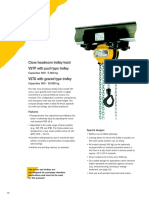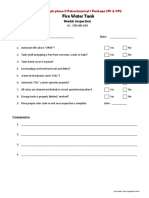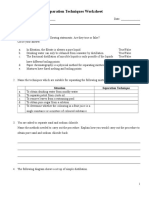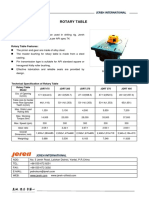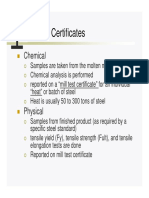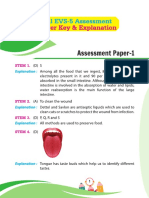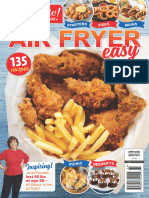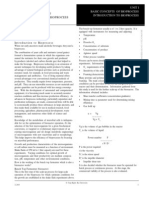Cargo Inspection Checklist
Cargo Inspection Checklist
Uploaded by
Aek JayCopyright:
Available Formats
Cargo Inspection Checklist
Cargo Inspection Checklist
Uploaded by
Aek JayOriginal Description:
Original Title
Copyright
Available Formats
Share this document
Did you find this document useful?
Is this content inappropriate?
Copyright:
Available Formats
Cargo Inspection Checklist
Cargo Inspection Checklist
Uploaded by
Aek JayCopyright:
Available Formats
CARGO INSPECTION CHECKLIST
Partnership Institution: _____________________________________________________
Location of inspection (city, state): ___________________________________________
Date of inspection: ________________________________________________________
Name of inspector: ________________________________________________________
1. SURVEY CARGO DATA SUMMARY (visual estimate)
In order to be transported in a sea container, cargo must fall within volume and weight parameters.
A sea container must be filled to at least 75% of its capacity by volume or by weight. The
minimum requirement for a 20-foot container is 800 cubic feet or 22,000 lbs.: for a 40-foot
container 1800 cubic feet or 33,000 lbs. In addition, total cargo weight should not exceed the US
road restrictions of 35,000 lbs. for a 20-foot and 45,000 lbs. for a 40-foot.
To determine whether or not cargo falls within these parameters, please fill in the following
information:
A. Estimated total volume of cargo in cubic feet: ______________________
B. Estimated total weight of cargo in pounds: _________________________
C. Estimated total number of pieces (boxes): __________________________
D. Estimated total value of cargo: __________________________________
For the following Sections II and III please explain the circumstances of answers checked “NO” in part
VI at the end of this checklist.
II. PACKAGE INSPECTION (visual estimate/spot inspection)
Please estimate the different types of packages as a percentage of the total quantity.
A. Packaging of Pieces (visual estimate)
1. Percentage of palletized pieces ____________________
2. Percentage of unpalletized pieces ____________________
3. All pieces are less than 90-foot in height? _______Yes ________ No
4. All pieces are lighter than 10,000 lbs.? _______ Yes _______ No
5. In your opinion, all pieces are forkliftable? _______ Yes _______ No
B. Package Condition – All packages are clean, dry and sealed (i.e. there is no visual evidence
of broken, squashed or sagging containers or water/mildew damage, vermin infestations,
punctures, leakage or other obviously unsafe or undesirable conditions)? _______ Yes
_______ No
C. Are fragile and other items requiring special handling packed appropriately to prevent
damage? _______ Yes _______ No
D. Are medical consumables in their original packing and do at least 14 months remain prior
to expiration?
_______ Yes _______ No
E. Do electrical items run on 220/240 volts/50 cycles (60 for Georgia) or are they being
shipped with transformers? _______ Yes _______ No
F. All spot-checked items are listed on the inventory sheet?
________ Yes _______ No
G. If pharmaceuticals: are medicines in original packaging and do at least 14
months remain prior to expiration?
________ Yes _______ No
H. Do the pharmaceuticals require special packing (i.e. HAZMAT)?
________ Yes _______ No
III. PACKAGE LABELING (spot inspection)
A. Please locate and confirm piece #1 of 1 and the very last numbered piece (example #50 of
50). Were they found and confirmed?
________ Yes _______ No
B. All observable cargo is represented on the packing list provided by the applicant?
________ Yes _______ No
C. The label on the box is clearly displayed and includes the complete address and
organization to receive the cargo?
________ Yes ______ No
OVERALL RECOMMENDATIONS AND COMMENTS: (Is there any reason why this cargo would be
unsuitable for transportation in a sea container?)
You might also like
- Food Safety QuestionnaireDocument4 pagesFood Safety QuestionnaireSheredapple Orticio100% (3)
- DOCUMENT 3 - Food Safety Quiz + GMPDocument8 pagesDOCUMENT 3 - Food Safety Quiz + GMPharmanjotSinghNo ratings yet
- Asphalt Plant Inspection ChecklistDocument16 pagesAsphalt Plant Inspection ChecklistJagan Mohana Rao Chinnala100% (3)
- Wacs SQDocument4 pagesWacs SQMarie AlejoNo ratings yet
- ANNEXURE XIX (GMP-Questionnaire For Packing Material Suppliers) MerckDocument17 pagesANNEXURE XIX (GMP-Questionnaire For Packing Material Suppliers) Merckyagnaashi9092No ratings yet
- Internal Quality Assurance MonitoringDocument5 pagesInternal Quality Assurance MonitoringMarlowe Deocampo100% (1)
- Maritime Declaration of Health 3Document1 pageMaritime Declaration of Health 3Geoffrey AchasNo ratings yet
- Pest Control Checklist: Management of Physical FacilityDocument1 pagePest Control Checklist: Management of Physical Facilitysaad100% (1)
- Yale VSTDocument2 pagesYale VSTAek JayNo ratings yet
- Qc-Fm-090-02-Incoming Finished Goods Inspection ChecklistDocument2 pagesQc-Fm-090-02-Incoming Finished Goods Inspection ChecklistJanice LeeNo ratings yet
- Kitchen Safari Intro ActivityDocument3 pagesKitchen Safari Intro ActivityestherNo ratings yet
- Restaurant / Liquor QuestionnaireDocument2 pagesRestaurant / Liquor QuestionnaireNaui ZualiNo ratings yet
- Transporters Checklist: Transporter Requirements (40 CFR 263)Document7 pagesTransporters Checklist: Transporter Requirements (40 CFR 263)Shrikant GuptaNo ratings yet
- Empty Parcel Form (Final)Document1 pageEmpty Parcel Form (Final)devanshkatiyar122No ratings yet
- Appendix 5 SW ChecklistDocument1 pageAppendix 5 SW Checklistnuraqilahma96No ratings yet
- Housekeeping ChecklistdateDocument5 pagesHousekeeping ChecklistdateLydia LabradorNo ratings yet
- Template Investigation of Sterility Test FailureDocument4 pagesTemplate Investigation of Sterility Test FailureMina Maher Mikhail100% (1)
- 9th Class Biology PBA PAPERDocument9 pages9th Class Biology PBA PAPERhadiabdul56755No ratings yet
- Checklist - Scheduled Wastes StorageDocument1 pageChecklist - Scheduled Wastes StorageMaintNo ratings yet
- Fire Water TankDocument1 pageFire Water TankAnonymous yCpjZF1rF100% (1)
- Tle 10-Long Quiz-Q3Document3 pagesTle 10-Long Quiz-Q3JNA Moments and IdeasNo ratings yet
- United India Insurance Company Limited: Head Office: 24, WHITES ROAD, CHENNAI - 600014Document3 pagesUnited India Insurance Company Limited: Head Office: 24, WHITES ROAD, CHENNAI - 600014AKvermaNo ratings yet
- Checklist1 - Good Housekeeping Safety InspectionDocument6 pagesChecklist1 - Good Housekeeping Safety InspectioncpborneoNo ratings yet
- P 5 SciDocument8 pagesP 5 Scikayzpepe212No ratings yet
- Monitoring Tool For SBI 2016Document6 pagesMonitoring Tool For SBI 2016Geline Joy D. SamillanoNo ratings yet
- Revised Physicaland Chemical Property LabDocument5 pagesRevised Physicaland Chemical Property LabDima SakrNo ratings yet
- Batch Manufacturing RecordDocument4 pagesBatch Manufacturing RecordAkik Sasmal100% (2)
- Mystery-Shopper-Questionnaire (1) (1) .Docx665558f8cd01d13586Document3 pagesMystery-Shopper-Questionnaire (1) (1) .Docx665558f8cd01d13586ogarivincent20No ratings yet
- Separation Techniques WorksheetDocument2 pagesSeparation Techniques WorksheetJESSAH MAE GAMUTANNo ratings yet
- Separation Techniques WorksheetDocument2 pagesSeparation Techniques WorksheetYerlin MendezNo ratings yet
- Separation Techniques WorksheetDocument2 pagesSeparation Techniques WorksheetJESSAH MAE GAMUTANNo ratings yet
- Separation Techniques Worksheet Ms Tay-1Document2 pagesSeparation Techniques Worksheet Ms Tay-1Anthony Benson50% (2)
- Separation Techniques Worksheet Ms Tay-1Document2 pagesSeparation Techniques Worksheet Ms Tay-1Candra SimanullangNo ratings yet
- Separation Techniques Worksheet Ms Tay-1Document2 pagesSeparation Techniques Worksheet Ms Tay-1Fathimath ShiyaraNo ratings yet
- 531611105933N Skripsi Open Access2Document2 pages531611105933N Skripsi Open Access2willy wilantaraNo ratings yet
- Lilongwe University of Agriculture and Natural ResourcesDocument7 pagesLilongwe University of Agriculture and Natural ResourcesmgNo ratings yet
- Assessment Tle 7Document3 pagesAssessment Tle 7John CatarinaNo ratings yet
- GS Preprof OSCE 2020 Sir SyedDocument13 pagesGS Preprof OSCE 2020 Sir Syedhomit kumarNo ratings yet
- Checklist MalariaDocument8 pagesChecklist MalariafihangasaNo ratings yet
- PV Inquiry Information Sheet REV ADocument2 pagesPV Inquiry Information Sheet REV Aapi-4268914100% (2)
- Checklist4 - Industrial Hygiene InspectionDocument4 pagesChecklist4 - Industrial Hygiene InspectioncpborneoNo ratings yet
- 1st Periodical Test TLEDocument10 pages1st Periodical Test TLEMila Mendoza LlarenaNo ratings yet
- Controlling Variables: I. Problem II. MaterialsDocument1 pageControlling Variables: I. Problem II. MaterialsRanulfo MayolNo ratings yet
- Cookery 8 FinalDocument4 pagesCookery 8 FinalElena moralesNo ratings yet
- Site Monitoring Checklist: TrashDocument4 pagesSite Monitoring Checklist: TrashAssem ElhajjNo ratings yet
- Halitosis QuestionnaireDocument3 pagesHalitosis Questionnairealumera50% (2)
- PAPER 3 - C5 - Google DocsDocument3 pagesPAPER 3 - C5 - Google DocsSushanti ElviraNo ratings yet
- Reinforcement - Grade7 Google ClassroomDocument6 pagesReinforcement - Grade7 Google ClassroomSaima Usman - 41700/TCHR/MGBNo ratings yet
- Answer Sheet in TLE 7 Week 3Document2 pagesAnswer Sheet in TLE 7 Week 3Rd DavidNo ratings yet
- Hazardous Waste Store - Weekly Inspection ChecklistDocument1 pageHazardous Waste Store - Weekly Inspection ChecklistRobert R. RaoNo ratings yet
- First Quarter Exam in TLE 9Document3 pagesFirst Quarter Exam in TLE 9Jansen BacoloresNo ratings yet
- Safety Inspection ChecklistDocument6 pagesSafety Inspection ChecklistJefferson Palabao LugoNo ratings yet
- in Your Own Words What Can You Say About The Products Being Offered, What Are Your Suggestions To Improve The Public Market's Products?Document6 pagesin Your Own Words What Can You Say About The Products Being Offered, What Are Your Suggestions To Improve The Public Market's Products?Beatrix Dela CruzNo ratings yet
- Success SCI Set 7 2020Document10 pagesSuccess SCI Set 7 2020mirriamkyomuhendoNo ratings yet
- Name: - Subject: Science Strand: Biology Grade:VII Date: - TIME ALLOWED: 15 Mins. Revision: How Plants GrowDocument1 pageName: - Subject: Science Strand: Biology Grade:VII Date: - TIME ALLOWED: 15 Mins. Revision: How Plants Growshaha waseemNo ratings yet
- Kidney and Urinary Disorder QuestionnaireDocument2 pagesKidney and Urinary Disorder Questionnairejeevan820No ratings yet
- Sci 0779680288 What's App OnlyDocument10 pagesSci 0779680288 What's App Onlyjamesremiraze4No ratings yet
- Security Survey CHK ListDocument15 pagesSecurity Survey CHK ListKazi Mazzad Ahmed Titas100% (2)
- Accident Prevention Plan: Review ChecklistDocument5 pagesAccident Prevention Plan: Review ChecklistGamaliel VentoNo ratings yet
- Using the Right Brain for Math -Multiplication and Division for KidsFrom EverandUsing the Right Brain for Math -Multiplication and Division for KidsRating: 1 out of 5 stars1/5 (1)
- Sterling Test Prep OAT Organic Chemistry Practice Questions: High Yield OAT Organic Chemistry QuestionsFrom EverandSterling Test Prep OAT Organic Chemistry Practice Questions: High Yield OAT Organic Chemistry QuestionsNo ratings yet
- ASTM Annual BookDocument3 pagesASTM Annual BookAek Jay100% (1)
- Evaluation of AISI 4140 Steel Repair Without Post-Weld Heat TreatmentDocument9 pagesEvaluation of AISI 4140 Steel Repair Without Post-Weld Heat TreatmentAek JayNo ratings yet
- Weld Procedure Summary: SR# Wps No. Process Aws No. P.No. Base Metal Thickness Range Diameter Range PWHTDocument5 pagesWeld Procedure Summary: SR# Wps No. Process Aws No. P.No. Base Metal Thickness Range Diameter Range PWHTshantilalNo ratings yet
- AMERICAN WIDE FLANGE BEAMS: Dimensions and PropertiesDocument1 pageAMERICAN WIDE FLANGE BEAMS: Dimensions and PropertiesAek JayNo ratings yet
- Steel and Cast IronDocument20 pagesSteel and Cast IronAek JayNo ratings yet
- Rotary TableDocument1 pageRotary TableAek JayNo ratings yet
- Construction Steel GirderDocument11 pagesConstruction Steel GirderAek JayNo ratings yet
- 820 - 5 - X - Sample Inspection Checklists PDFDocument6 pages820 - 5 - X - Sample Inspection Checklists PDFAek JayNo ratings yet
- Welding Fume Fact SheetDocument2 pagesWelding Fume Fact SheetAek JayNo ratings yet
- Angle Grinder SOPDocument1 pageAngle Grinder SOPAek JayNo ratings yet
- Set 8-3 PDFDocument56 pagesSet 8-3 PDFAek JayNo ratings yet
- Gas Turbine ConsultancyDocument4 pagesGas Turbine ConsultancyAek Jay100% (1)
- Using Hybrid Laser-Arc Welding To Reduce Distortion in Ship PanelsDocument5 pagesUsing Hybrid Laser-Arc Welding To Reduce Distortion in Ship PanelsaliNo ratings yet
- Naffco-Psv-Pc Application ProcedureDocument5 pagesNaffco-Psv-Pc Application Procedureimad qaissouniNo ratings yet
- Safal 5 - AssesmentDocument45 pagesSafal 5 - AssesmentSatyam KanwarNo ratings yet
- Coc 1 NciiiDocument9 pagesCoc 1 NciiiFlor PeraltaNo ratings yet
- Errata 6th-Ed 4-MalletDocument2 pagesErrata 6th-Ed 4-MalletOier CaceresNo ratings yet
- Service Manual Canon L100 L120 SeriesDocument158 pagesService Manual Canon L100 L120 Seriesedijhon5815No ratings yet
- Dr. Booth Report On Cell Tower at SchoolDocument6 pagesDr. Booth Report On Cell Tower at SchoolSafe Tech For SchoolsNo ratings yet
- The BrainDocument28 pagesThe BrainAnania EmmanuelNo ratings yet
- Math Test ExampleDocument4 pagesMath Test Exampledan8818No ratings yet
- Ch18 ClassificationDocument18 pagesCh18 ClassificationAdam SmithNo ratings yet
- 08 Uznkatalogs EngDocument11 pages08 Uznkatalogs EngIvo KolinsNo ratings yet
- (Ebook - PDF) Guide Du Karate, Aikido, Kendo, Judo - 134 Pages (Sport) (Arts Martiaux) (Combat) (Art Martial)Document134 pages(Ebook - PDF) Guide Du Karate, Aikido, Kendo, Judo - 134 Pages (Sport) (Arts Martiaux) (Combat) (Art Martial)Rafhael Sampaio100% (1)
- Ohe Parallel Groove (P.G.) ClampsDocument5 pagesOhe Parallel Groove (P.G.) ClampsPiyush SinghNo ratings yet
- Topaire Cassete Aircond CatelogDocument6 pagesTopaire Cassete Aircond CatelogBina Integrated Technology Terengganu Sdn BhdNo ratings yet
- Celebrate! With Woman's World - Air Fryer Easy - 2023 USDocument100 pagesCelebrate! With Woman's World - Air Fryer Easy - 2023 UStrekaNo ratings yet
- Lebanese International University School of EngineeringDocument12 pagesLebanese International University School of EngineeringHassan RashedNo ratings yet
- Cassidy Associates - Russian Tenex Nuclear LobbyingDocument39 pagesCassidy Associates - Russian Tenex Nuclear LobbyingZerohedgeNo ratings yet
- Lecture - The Pulse of Aerospace CFDDocument4 pagesLecture - The Pulse of Aerospace CFDHamdani MesinNo ratings yet
- Rafat PHD 220829 193731Document191 pagesRafat PHD 220829 193731Miftahul JannahNo ratings yet
- (English) ENHYPEN (엔하이픈) 'SO SO FUN' EP.3 (DownSub.com)Document37 pages(English) ENHYPEN (엔하이픈) 'SO SO FUN' EP.3 (DownSub.com)Darin XVKT10No ratings yet
- Introduction To Bio ProcessDocument2 pagesIntroduction To Bio Processstanley00109100% (1)
- Final Project Report MRI ReconstructionDocument19 pagesFinal Project Report MRI ReconstructionGokul SubramaniNo ratings yet
- Electrical Clearances For Transmission Line Gesign at The Higher VoltagesDocument9 pagesElectrical Clearances For Transmission Line Gesign at The Higher VoltagesPablo LiwderbadNo ratings yet
- Diamonds Thesis Guns Germs SteelDocument5 pagesDiamonds Thesis Guns Germs Steelafbwszvft100% (2)
- Bubble Coral FactsDocument4 pagesBubble Coral FactsSeok WilliamsNo ratings yet
- Varicose Veins SYNOPSISDocument2 pagesVaricose Veins SYNOPSISZlata PinotićNo ratings yet
- Brochure Eurohinca EnglishDocument8 pagesBrochure Eurohinca EnglishNelson Filipe Monteiro NascimentoNo ratings yet
- Ethnobotanical Study and Traditional Use of Autochthonous Pear Varieties (Pyrus Communis L.) in Southwest Serbia (Polimlje)Document21 pagesEthnobotanical Study and Traditional Use of Autochthonous Pear Varieties (Pyrus Communis L.) in Southwest Serbia (Polimlje)Aleksandra SavićNo ratings yet
- Geography Ss2 3rd TermDocument4 pagesGeography Ss2 3rd Termquwiyyiayomide1No ratings yet
- Montagem Motor HidraulicoDocument20 pagesMontagem Motor Hidraulicoeduardo SeverinoNo ratings yet








